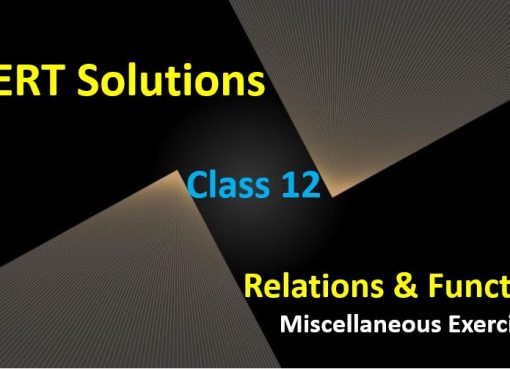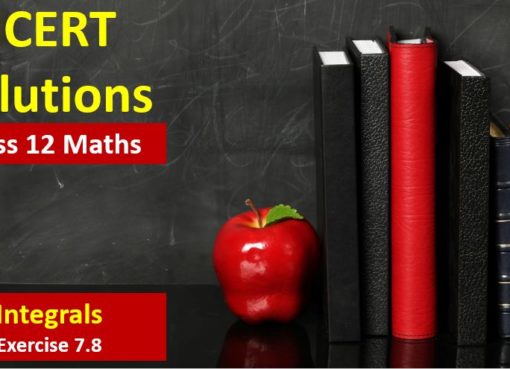NCERT Solutions for Class 12 Maths Matrices
Hi Students, Welcome to Amans Maths Blogs (AMB). In this post, you will get the NCERT Solutions for Class 12 Maths Matrices Exercise 3.1. This NCERT Solutions can be downloaded in PDF file. The downloading link is given at last.
NCERT Solutions for Class 12 Maths are not only the solutions of Maths exercise but it builds your foundation of other important subjects. Getting knowledge of depth concept of CBSE Class 12th Maths like Algebra, Calculus, Trigonometry, Coordinate Geometry help you to understand the concept of Physics and Physical Chemistry.
CBSE Class 12th is an important school class in your life as you take some serious decision about your career. And out of all subjects, Maths is an important and core subjects. So CBSE NCERT Solutions for Class 12th Maths is major role in your exam preparation as it has detailed chapter wise solutions for all exercise.
As we know that all the schools affiliated from CBSE follow the NCERT books for all subjects. You can check the CBSE NCERT Syllabus. Thus, NCERT Solutions helps the students to solve the exercise questions as given in NCERT Books.
NCERT Solutions for Class 12 Maths Matrices Exercise 3.1
NCERT Solutions for Class 12 Maths Matrices Exercise 3.1: Ques No 1.
In the matrix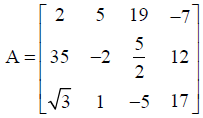 , write.
, write.
(a) The order of the matrix
(b) The number of elements
(c)Write the elements a13, a21, a33, a24, a23.
NCERT Solutions:
(a) In the given matrix, the number of rows is 3 and the number of columns is 4. Therefore, the order of the matrix is 3 x 4.
(b) The number of elements is 3 x 4 = 12.
(c) a13 = 19, a21 = 35, a33 = -5, a24 = 12, a23 = 5/2.
NCERT Solutions for Class 12 Maths Matrices Exercise 3.1: Ques No 2.
If a matrix has 24 elements, what are the possible orders it can have? What, if it has 13 elements?
NCERT Solutions:
We know that if a matrix is of the order m x n, it has mn elements.
Thus, to find all the possible orders of a matrix having 24 elements, we have to find all the ordered pairs of natural numbers whose product is 24.
Since 24 = 1 x 24 = 2 x 12 = 3 x 8 = 4 x 6, then the possible order of the matrix is
1 x 24 or 24 x 1; 2 x 12 or 12 x 2; 3 x 8 or 8 x3; 4 x 6 or 6 x 4.
If the matrix has 13 elements, then the possible order of the matrix is 1 x 13 or 13 x 1.
NCERT Solutions for Class 12 Maths Matrices Exercise 3.1: Ques No 3.
If a matrix has 18 elements, what are the possible orders it can have? What, if it has 5 elements?
NCERT Solutions:
We know that if a matrix is of the order m x n, it has mn elements.
Thus, to find all the possible orders of a matrix having 18 elements, we have to find all the ordered pairs of natural numbers whose product is 18.
Since 18 = 1 x 18 = 2 x 9 = 3 x 6, then the possible order of the matrix is
1 x 18 or 18 x 1; 2 x 9 or 9 x 2; 3 x 6 or 6 x 3;
If the matrix has 5 elements, then the possible order of the matrix is 1 x 5 or 5 x 1.
NCERT Solutions for Class 12 Maths Matrices Exercise 3.1: Ques No 4.
Construct a 2 × 2 matrix, A = [aij], whose elements are given by (i) aij = (i + j)2/2
NCERT Solutions:
A 2 x 2 matrix has two rows and two columns. Thus, it is denoted by .
.
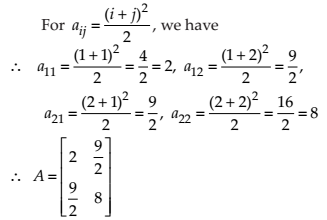
Construct a 2 × 2 matrix, A = [aij], whose elements are given by (ii) aij = i/j.
NCERT Solutions:
A 2 x 2 matrix has two rows and two columns. Thus, it is denoted by .
.
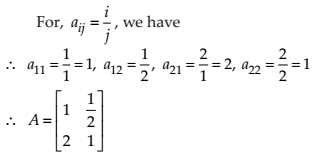
Construct a 2 × 2 matrix, A = [aij], whose elements are given by (i) aij = (i + 2j)2/2
NCERT Solutions:
A 2 x 2 matrix has two rows and two columns. Thus, it is denoted by .
.
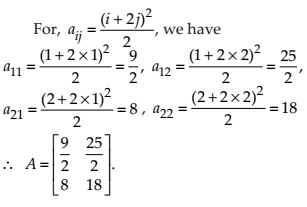
NCERT Solutions for Class 12 Maths Matrices Exercise 3.1: Ques No 5.
Construct a 3 × 4 matrix, A = [aij], whose elements are given by (i) aij = (1/2)| -3i + j |.
NCERT Solutions:
A 3 x 4 matrix has three rows and four columns. Thus, it is denoted by  .
.
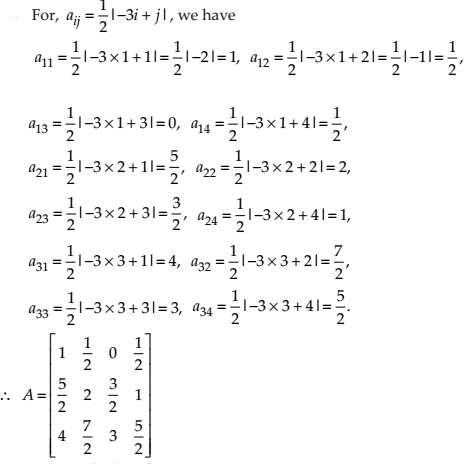
Construct a 3 × 4 matrix, A = [aij], whose elements are given by (ii) aij = 2i – j.
NCERT Solutions:
A 3 x 4 matrix has three rows and four columns. Thus, it is denoted by  .
.
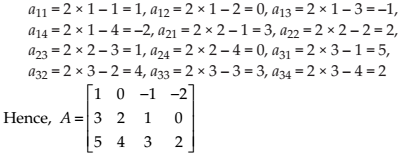
NCERT Solutions for Class 12 Maths Matrices Exercise 3.1: Ques No 6.
Find the values of x, y and z from the following equations: (i) .
.
NCERT Solutions:
In equal matrices, the corresponding elements are equal.
Thus, from the given matrices, we get x = 1, y = 4 and z = 3.
Find the values of x, y and z from the following equations: (ii) .
.
NCERT Solutions:
In equal matrices, the corresponding elements are equal.
Thus, from the given matrices, we have
x + y = 6 ⟹ y = 6 – x,
xy = 8
and 5 + z = 5 ⟹ z = 0.
Now, put y = 6 – x in xy = 8, then x(6 – x) = 8 ⟹ 6x – x2 = 8 ⟹ x2 – 6x + 8 = 0 ⟹ (x – 4)(x – 2) = 0 ⟹ x = 2 or 4 ⟹ y = 4 or 2
Thus, x = 2, y = 4, z = 0 or x = 4, y = 2, z = 0.
Find the values of x, y and z from the following equations: (iii) .
.
NCERT Solutions:
In equal matrices, the corresponding elements are equal.
Thus, from the given matrices, we have
x + y + z = 9
x + z = 5 ⟹ x = 5 – z
and y + z = 7 ⟹ y = 7 – z
Now, put x = 5 – z and y = 7 – z in x + y + z = 9, then
Thus, 5 – z + 7 – z + z = 9 ⟹ z = 3 ⟹ x = 2 and y = 4
Therefore, x = 2, y = 4, z = 3.
NCERT Solutions for Class 12 Maths Matrices Exercise 3.1: Ques No 7.
Find the value of a, b, c and d from the equation: (i) .
.
NCERT Solutions:
In equal matrices, the corresponding elements are equal.
Thus, from the given matrices, we have
a – b = -1 ⟹ a = b – 1
2a – b = 0 ⟹ 2(b – 1) – b = 0 ⟹ b = 2 ⟹ a = 1
2a + c = 5 ⟹ 2 + c = 5 ⟹ c = 3
3c + d = 13 ⟹ 9 + d = 13 ⟹ d = 4
Thus, a = 1, b = 2, c = 3 and d = 4.
NCERT Solutions for Class 12 Maths Matrices Exercise 3.1: Ques No 8.
A = [aij]m × n is a square matrix, if
(A) m < n, (B) m > n, (c) m = n, (D) None of these
NCERT Solutions:
A = [aij]m × n is a square matrix, if m = n.
NCERT Solutions for Class 12 Maths Matrices Exercise 3.1: Ques No 9.
Which of the given values of x and y make the following pair of matrices equal?

NCERT Solutions:
A = [aij]m × n is a square matrix, if m = n.
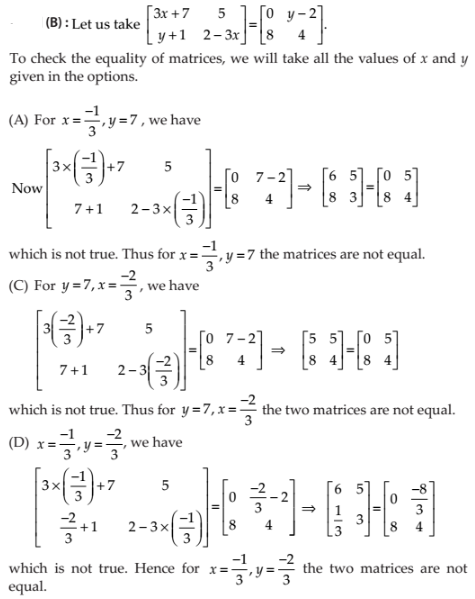
NCERT Solutions for Class 12 Maths Matrices Exercise 3.1: Ques No 10.
The number of all possible matrices of order 3 × 3 with each entry 0 or 1 is:
(A) 27, (B) 18, (c) 81, (D) 512
NCERT Solutions:
The matrix has 3 x 3 = 9 elements with the entries 0 or 1.
Thus, the number of possible matrices is 29 = 512.

